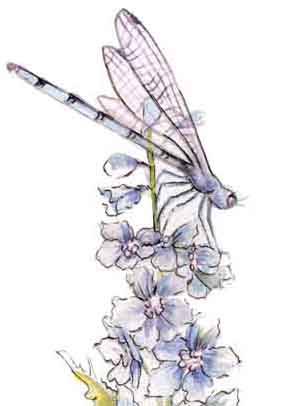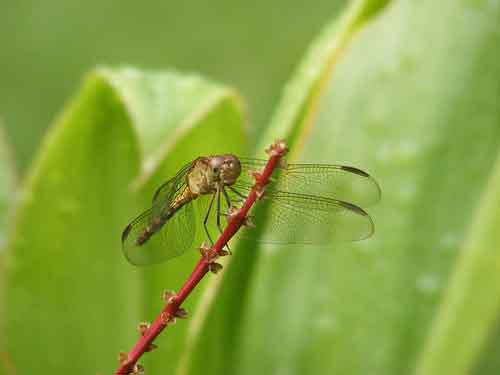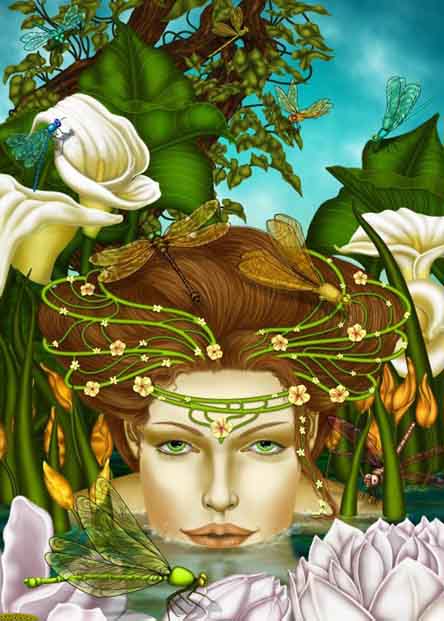The Dragonfly

A dragonfly is an insect belonging to the order Odonata, the suborder Epiprocta or, in the strict sense, the infraorder Anisoptera. It is characterized by large multifaceted eyes, two pairs of strong transparent wings, and an elongated body. Dragonflies typically eat mosquitoes, midges and other small insects like flies, bees, and butterflies. They are usually found around lakes, ponds, streams, and wetlands because their larvae, known as "nymphs", are aquatic.
Dragonflies do not normally bite or sting humans (though they will bite in order to escape, for example, if grasped by the abdomen); in fact, they are valued as a predator that helps control the populations of harmful insects, such as mosquitoes. It is because of this that dragonflies are sometimes called "mosquito hawks" in North America along with the Crane Fly (which, in fact, does not eat mosquitoes).
Female dragonflies lay eggs in or near water, often in or on floating or emergent plants. Some species when laying eggs will submerge themselves completely just to lay their eggs in a suitable place. Most of the life of the dragonfly is spent in the larval, (naiad, aka nymph) form, beneath the water surface, using internal gills to breathe, and using extendable jaws to catch other invertebrates or even vertebrates such as tadpoles and fish. The larvae of large dragonflies may live as long as five years, or two months to three years in smaller species. When the the larva is ready to metamorphose into an adult, it climbs up a reed or other emergent plant at night, and when it does the breathing pattern changes inside the larvae's body. Then the skin splits at a weak spot behind the head and the adult dragonfly crawls out of its old larval skin, waits for the sun to rise, pumps up its wings and flies off to feed on midges and flies. In the adult stage, larger species of dragonfly can live as long as four months.
Ancient dragonflies ("Anisozygoptera")
Conventionally, the Anisoptera were given suborder rank beside the ancient dragonflies ("Anisozygoptera", two living species and numerous fossil ones), but it has been determined recently that the Anisozygoptera form a paraphyletic assemblage of primitive relatives of the Anisoptera. Thus, the Anisoptera are reduced to an infraorder, forming the new suborder Epiprocta (dragonflies in a general sense). The artificial grouping Anisozygoptera is disbanded, its members being recognized as largely extinct offshoots at various stages of dragonfly evolution.
The oldest known species of dragonfly is the 320 million year old Delitzschala bitterfeldensis. Another old genus is Namurotypus.
Dragonfly Wikipedia
Dragonfly Symbology

The Dragonfly symbolizes the power of light and Illusion. The dragonfly inhabits two realms: air and water and the influence of both these elements will be felt by Dragonfly people. They will be emotional and passionate during their early years (the influence of water) and more balanced with greater mental clarity and control in as they mature (the influence of air).
Dragonfly is the essence of the winds of change, the messages of wisdom and enlightenment; and the communication from the elemental world. Dragonfly medicine beckons you to seek out the parts of your habits which need changing. Call on Dragonfly to guide you through the mists of illusion to the pathway of transformation.
The number 2 is important to Dragonfly, so think in terms of two year periods when you begin a change. Dragonfly brings the light and color of transformation into your life.
Dragonflies, or damselflies, were connected to Freya the Norse goddess of love, fertility and warfare. Freya was famous for her beauty and her knowledge as a magician. It was she who taught Odin the shamanic practices known as seidr which were still practiced during Christian times. The paired bodies of mating dragonflies form the shape of a heart, perhaps being the source for that modern symbol of love. In ancient lore, the dragonfly represents transformation, adaptation and insight.
Dragonfly Folklore and Mythology

In most cultures dragonflies have been objects of superstition. European folklore is no exception. Many old myths have been lost during the history, but fragments of these old myths are still living in old local names for dragonflies.
Only in Germany have dragonflies had over 150 different names. Some of these are Teufelsnadel ("Devil's needle"), Wasserhexe ("Water witch"), Hollenross ("Goddess' horse"), Teufelspferd ("Devil's horse") and Schlangentöter ("Snake killer"). The name Snake Doctor has been used in Germany.
In England the name Devil's darning needle and Horse stinger have been used. In Denmark the dragonfly have got such different names as Fandens ridehest ("Devil's riding horse") and Guldsmed("Goldsmith").
Different names of dragonflies referring to them as the devils tools have also occurred in many other European cultures, some examples are the Spanish Caballito del Diablo ("Devil's horse") and the Frenchl'aiguille du diable ("Devil's needle").
During the history the dragonflies even have been connected with love and female, the names damselfly (England), Demoiselle (France) and Jungfer (Germany) are some examples of those nice associations.
In certain parts of Norway, the dragonfly is also known as "oslash;rsnildra". The exact meaning of this word is unknown to me but the part "oslash", does obviously refer to the Norwegian word for "ear", as people (and especially children) often thought that the dragonfly would poke holes in their ear-drums if it got inside their ears.
The Swedish name for dragonfly is trollslända, which means "hobgoblin fly" in English. Long time ago people in Sweden believed that hobgoblins, elves, brownies and such creatures lived in our great woods. In that folklore the dragonflies was considered to be the hobgoblins twisting tools.
An old Swedish name for dragonfly is Blindsticka ("Blind stinger"), this name comes from the opinion that a dragonfly could pick out your eyes. Other people thought that the dragonfly could sew together your eyelids. The same name appears as well in Norway ("Öyenstikker") as in Germany ("Augenstecher").
Another old Swedish name is Skams besman ("Devil's steelyard"), this name probably depends on the dragonfly's body shape that, with some imagination looks like the weighting tool. In the folklore this was interpreted as that the Devil used the dragonfly to weight the people's souls. When a dragonfly flew around your head, your soul was weighted and you should expect seriously injury as punishment. It is very interesting that, despite of those ideas that the dragonfly should be the Devil's tool, the dragonfly have been a holy animal in Scandinavia. In the Æsir cult the dragonfly was thought to be the love goddess Freya's symbol.
Some of the Latin names of dragonfly families have interesting meanings: The name Libellula might have been derived from the word libella ("booklet") referring to the resting dragonfly, which wings, with some imagination, looks quite like the pages of an open book.
The name Odonata was created by Fabricius in 1793 as name for the whole dragonfly order, means "toothed".
Dragonfly Prophecy
Quote from the book Mystery of The Crystal Skulls ...
"The Maya considered the dragonfly to be one of the symbols of Kukulcan also known as Quetzalcoatl whose spirit is said to be connected with the fulfillment of the Mayan Calendar." December 21, 2012
I did NOT write any of this! I just wanted to share this and love how this is put. For where I got this click here >Source: http://www.crystalinks.com/dragonfly.html
Namaste
Brittany
No comments:
Post a Comment